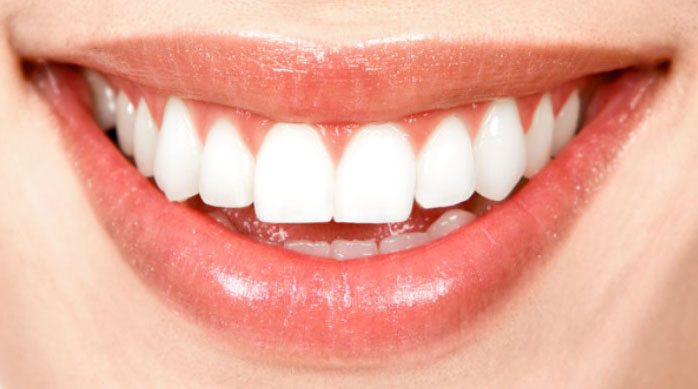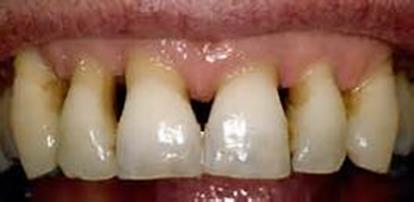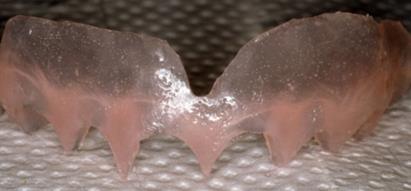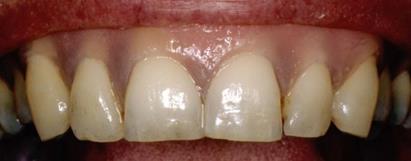The area of soft tissue and teeth displayed, when a patient smiles is often referred to as the aesthetic zone and usually includes the teeth in the maxillary arch anterior to the second premolar (Fig 1).

Fig 1. The aesthetic zone
Periodontal diseases result in damage and destruction of the supporting structures of the teeth, including the bone and periodontal ligament. In some cases, there is loss of gingival coverage of the teeth in aesthetic regions, with gingival recession and loss of interdental papilla (Fig. 2).

Fig 2. Gingival recession and loss of interdental papilla (Black triangle).
Periodontal attachment loss in this region can often lead to aesthetic and functional problems. One of the problems is the visible interdental space or black triangles (Fig. 2). Black triangle can be defined as “any interproximal soft tissue loss due to periodontal disease, traumatic, mechanical or chemical preparation or crown lengthening procedures”. These lead not only aesthetic and phonetic problems but also difficulty in maintaining oral hygiene. Patients’ awareness and expectations have increased to the point that less than optimal aesthetics is no longer accepted. Therefore selecting the best aesthetic prosthetic treatment for teeth with gingival recession in the anterior region may be a challenge.
Surgical techniques advocated for recreating gingival architecture around recession or alveolar defects are technique-sensitive; may require a graft from an additional surgical site with consequent additional morbidity and have unpredictable outcome when used to replace a large volume of tissue. The surgical treatment in such situations is costly, requires prolonged healing time, and the results are often unpredictable; this makes it an unpopular choice.
A simple procedure for the management of both gingival recession and loss of inter dental papilla is the use of gingival prosthesis. A gingival veneer (Fig. 3) is a prosthesis worn in the labial aspect of the dental arch, which aims to restore the mucogingival contour and aesthetics in areas where periodontal tissues are deficient. Also known as gingival mask, gingival epithesis or the artificial gums, they were first introduced in 1955 by Emslie to mask the unaesthetic appearance of gingival recession in a patient who underwent gingivectomy.

Fig. 3 Gum veneer
The veneers were accepted very well by patients because of the improved aesthetics (Fig. 4). They have also been used as a vehicle for delivering topical medications such as topical fluoride, or triamcinolone 0.1% in dental paste for the treatment of desquamative gingivitis, and as a carrier for periodontal dressings.

Fig. 4 Improved aesthetics
Various materials that can be used for fabrication of gingival veneers include:
- Auto and heat polymerizing acrylic resins
- Co-polyamide
- Soft silicone materials
The indications of gingival veneers include:
- Poor aesthetics due to interdental black triangles, exposed root surfaces, and/or crown margins
- Food impaction in interdental spaces
- Lack of saliva control
- Impaired phonation
- Root-dentine sensitivity
- In interdental defects with > 5 mm gap between contact point and alveolar crest
- When the patient cannot undergo repeated surgical procedures
The contraindications include:
- Allergy to the fabrication materials
- Patients with poor or unstable periodontal health
- Poor oral hygiene
- Patients with high caries activity
- Limited manual dexterity
References
- Azzi R, Etienne D, Carranza F. Surgical reconstruction of the interdental papilla. The International journal of periodontics & restorative dentistry. 1998 Oct;18(5):466-73. PubMed PMID: 10093523. Epub 1999/03/27. eng.
- Gopakumar A, Sood B. Conservative management of gingival recession: the gingival veneer. Journal of esthetic and restorative dentistry : official publication of the American Academy of Esthetic Dentistry [et al]. 2012 ec;24(6):385-93. PubMed PMID: 23205684. Epub 2012/12/05. eng.
- Greene PR.: The flexible gingival mask: an esthetic solution in periodontal practice. Brit Dent Jour. 1998; 11(184): 536-40.
- Hickey B, Jauhar S. Gingival veneers. Dent Update 2009;36:422-4, 426, 428.
- RaviShankar Y KS, Sumeet Kumar Sarma, Shameen Kumar P. Management of Black Triangles and Gingival Recession: A Prosthetic Approach. Indian Journal of Dental Sciences. March 2012;4(1).
| Last Reviewed | : | 11 May 2015 |
| Writer | : | Dr. Amirham bt. Ahmad |
| Accreditor | : | Datin Dr. Sorayah bt. Sidek |







